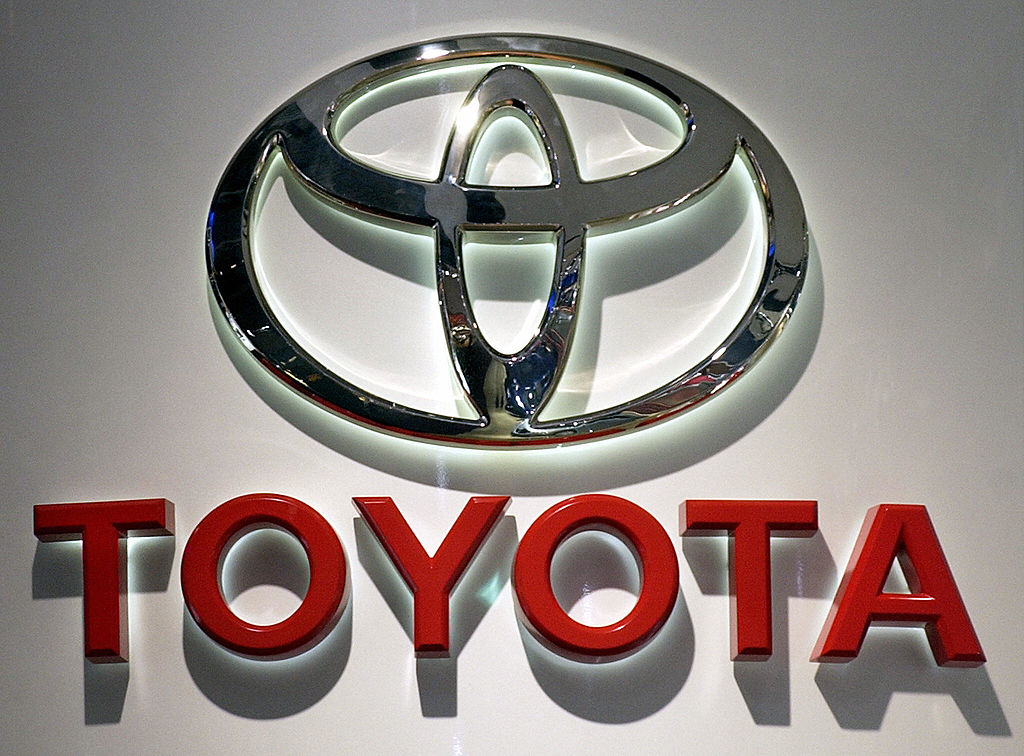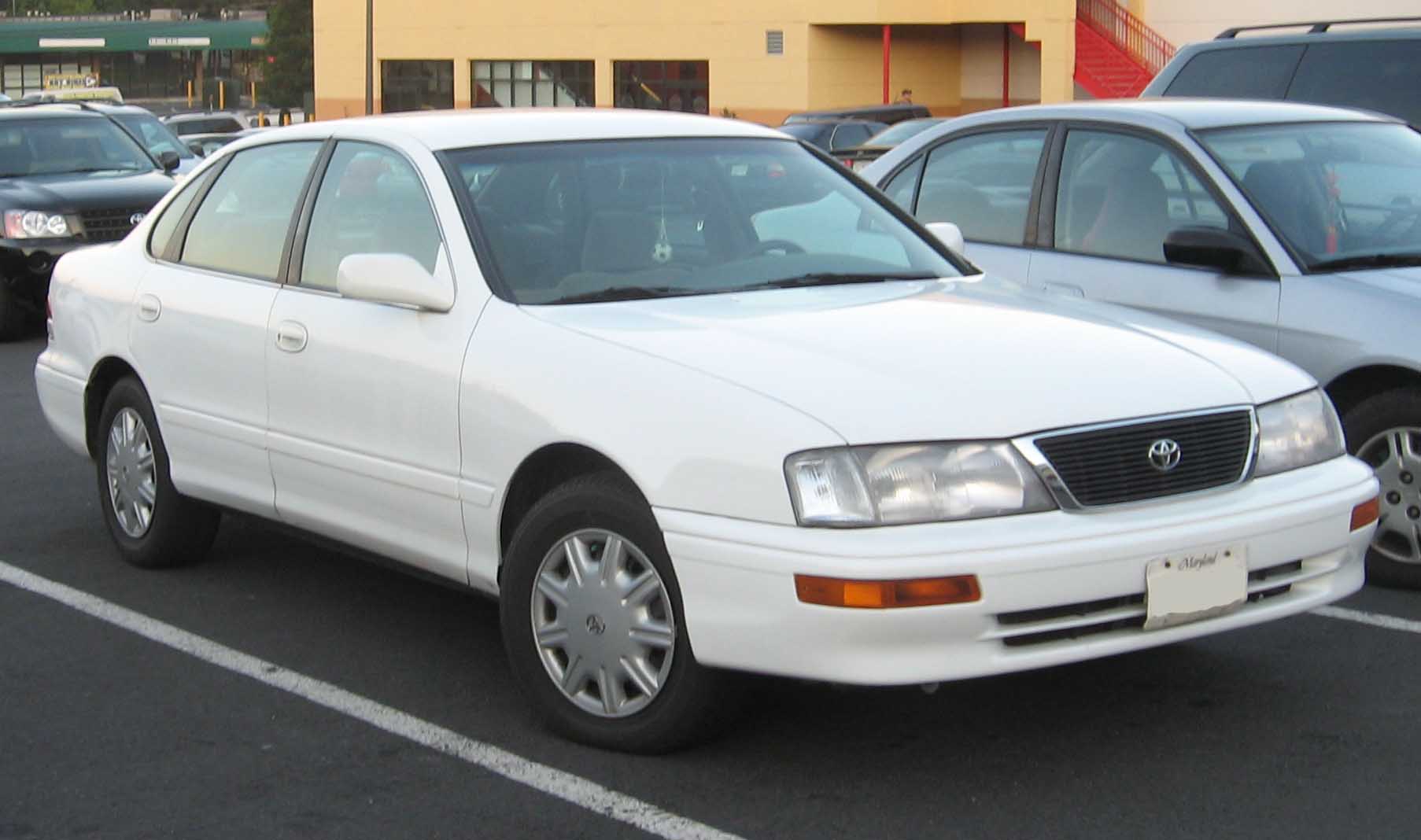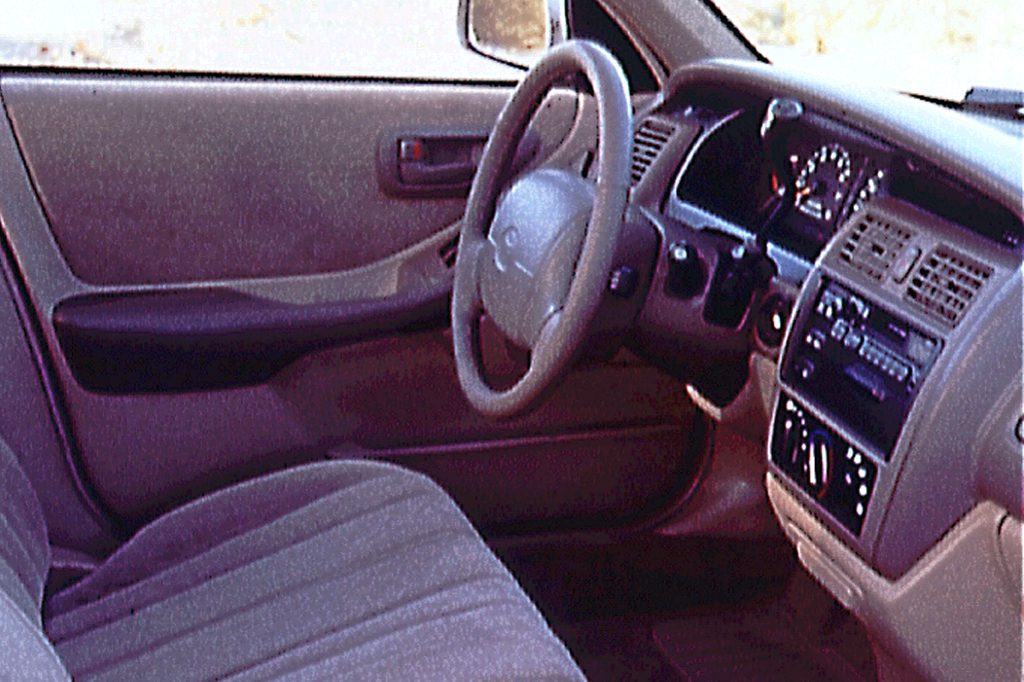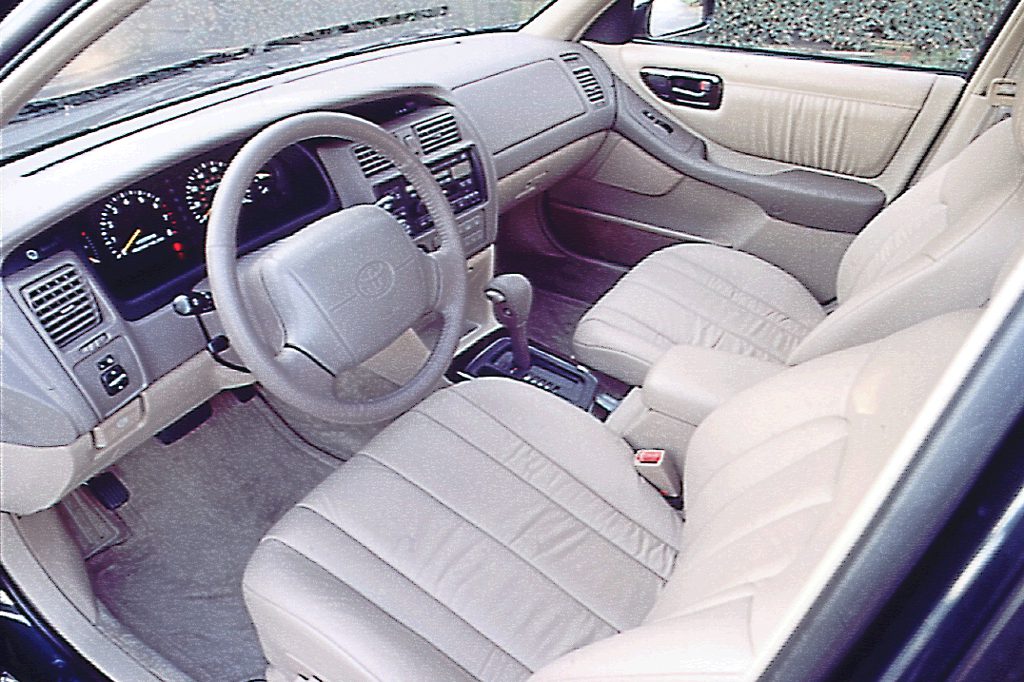mmcartalk
Expert
- Messages
- 4,159
- Reactions
- 2,675
MM Retro Write-Up: First-Generation Toyota Avalon.






^^^^^^Column shifter and front bench seat

^^^^^Bucket seat/console
(and a nice/no-zig-zag shift-lever)

IN A NUTSHELL: a 1990s-era Japanese Buick LeSabre without the reliability concerns.
In the mid/late 1980s through the early 1990s, the mid-sized Toyota Camry sedans, coupes, and wagons became a icon on American roads, essentially doing what the arch-rival Honda Accord had done, except with a somewhat smoother ride, more isolation from the road, and smoother-shifting automatic transmissions (Honda automatics of that period tended to be jerky). The Second-Generation Camry, of course, served as the basis for the Lexus ES250, which I covered in another write-up. The Third-Generation-Camry, introduced to the U.S. market for 1992 (and produced through the 1996 model year), was, IMO, the best Camry ever built…..(I also covered them in another write-up). I still see a lot of them in active use today, almost 30 years later.
The new Third-Generation Camry also served (in a slightly stretched/modified form) as the basis for Toyota’s first attempt to market a front-drive/full-sized sedan in the U.S., having previously sold the rear-drive Cressida for some years. It was unveiled at the Chicago Auto show in 1994, and introduced late that year as a 1995 model. Depending on the source, there is some confusion in automotive history as to whether the American-market Avalon was first intended to be sold as a Toyota flagship sedan, or simply as a Lexus front-drive sedan. In the end, of course, the decision was made to market it under the Toyota nameplate….at the risk of taking some Camry sales, which, for the most part, did not happen, as the Camry continued to sell in huge numbers, and the Avalon never even approached the Camry numbers.
But, IMO, that does not mean that the First-Generation Avalon, was inferior to the Third-Generation Camry in any way…..indeed, as I mentioned earlier, it was a slightly larger and more upmarket version of the Camry itself. It used the same standard 3.0L V6 of 194 HP/210 ft-lbs. of torque and ultra-smooth 4-speed automatic as American-market V6 versions of the Camry. Like the equivalent Camry, it was rock-solid in its quality and construction, and suffered few if any recalls or factory-defects, although you had to keep the oil and filter in the V6 changed religiously, by the book….it was not forgiving of even a small amount of laxity in drain/refill intervals, and could gel or sludge. That was because the oil-passage were designed to make the engine run hot for emissions reasons and non-synthetic (petroleum-based) oil simply broke down, after a while, from the heat.
But, that one issue aside, these cars were virtually bulletproof. In fact, that is one reason WHY they were introduced….Toyota noted that many Americans had bought 80s and early-90s-vintage full-sized front-drive GM, Ford, and Chrysler sedans that, particularly in the case of the GM products, had proved very troublesome and were causing their owners many problems. The Avalon was an attempt to cash in on that part of the market that wanted this type of car, didn’t want to pay the high prices that European competitors of this size commanded, and were tired of unreliability. In fact, the first-generation Avalon even offered somewhat, by then, was virtually unheard of in a Japanese sedan…..a front bench seat option, together with a traditional American-type column-shifter for the automatic. This version, of course, unlike the ones with front bucket seats and console, could carry six normal-adults in relative comfort, and included a front seat belt for the center front passenger. Eventually, on a couple of later-generations, the bench-seat/column-shifter option would be dropped. Like the Buicks/Lincolns/Cadillacs of the period, emphasis was put on sound-insulation and a smooth ride. In fact, as I noted up top, the First-Generation Avalon could be considered a Japanese Buick sedan, with much better quality inside and out although lacking the wood-tone trim on the domestic sedans (wood-tone trim would come on later Avalons).
While I did not own one, I had a fair amount of experience with the First-Generation Avalon, and, of course, with the equivalent Camrys of that period that served as its platform. In the mid-90s, the parents of my ex-Flight-Instructor were ready for a new sedan. He and I had remained friends (and still are to this day), and he and his family partly relied on my advice for new cars, partly on his own advice as a longtime Toyota owner, and partly on the advice of their son-in-law, who had married their daughter about 5-6 years previously (she is a saint...he's a darn-lucky guy).
 The parents were getting up in years and are now passed away, had owned a large front-drive 80s-vintage Buick LeSabre (I don’t remember exactly what year), that, typical of 80s-vintage GM stuff, was a PITA to own, with instant problems and things working loose on it. When they had finally had enough, we all got together, and it was suggested (and agreed to, by all of us), that the then-new Avalon was worth a look. They decided they would consider a white one (for safety and night-visibility), the bench-seat/column-shifter option, power seats, and power-mirrors (If my memory is right, not all of the Avalon had power seats).
The parents were getting up in years and are now passed away, had owned a large front-drive 80s-vintage Buick LeSabre (I don’t remember exactly what year), that, typical of 80s-vintage GM stuff, was a PITA to own, with instant problems and things working loose on it. When they had finally had enough, we all got together, and it was suggested (and agreed to, by all of us), that the then-new Avalon was worth a look. They decided they would consider a white one (for safety and night-visibility), the bench-seat/column-shifter option, power seats, and power-mirrors (If my memory is right, not all of the Avalon had power seats).
Well, of course, that exact combination was not particularly easy to find in stock (and, of course, in those days, you couldn’t find it on the Internet by pushing buttons like today). But, after a little bit of searching, Jim Coleman Toyota in Rockville, MD (that dealership also sold Cadillac and Infiniti) had one in stock that met that criteria, We all went to to look at it, looked it over. It passed my own test-drive, my flight-instructor’s test-drive, and their son-in-law’s test-drive, and (most importantly) the parent’s test-drive themselves. The decided they liked it, and so the bargaining started…that part, I generally stayed out of, since it wasn’t my money, but I would bring up anything that I thought was in issue in the car’s pricing. A deal was reached, thanks (as I remember it) mainly to their son-in-law, who could bargain like it was a Bazaar in the Middle East LOL. So, we shook hands, the car was PDI’ed, I gave it a final once-over inspection since I was considered the expert in the group in that field, and his parents took it home. I don’t recall what happened to their old Buick, if they sold it, traded it, or donated it….that part of the deal slips my memory, as this was some 25 years ago.
Not only at the dealership, but I did drive it a few times later on…..once on a trip out to Baltimore to pick up his parents (in their own car, of course), at the BWI Airport. (No, their son, my Flight Instructor, didn’t fly them back…by then, he had retired from flying and was in a Limo/Executive-car service). I really enjoyed that car on the trip out the BW (Baltimore-Washington) Parkway and back, with a few side-roads…..it was indeed a Japanese Buick without the quality-hassles., though a little less-plush with the dash-trim.
A Second-Generation Avalon was introduced in late 1999, for the 2000 model-year, and incorporated the Lexus-type back-illuminated dash lighting, but, in general, IMO, for a umber of reasons, was a disappointment and letdown from the very nice First-Generation model. I didn’t like the general style, body lines, slightly stiffer ride, or the materials as much as before. It wasn’t a bad car by any means….but, IMO, just not as nice as the previous model. The Third-Generation Avalon, introduced in 2004 for the 2005 model year, restored some of the ride/driving-comfort, and also included a real spare tire…something that, by then, was pretty much going the way of the Dodo in regular sedans. The Third-generation model also had wood-tone (in somewhat of an orangish swirl-patttern), I liked its general style, but cost-cutting continued inside with a lot of cheap/poorly-finished silver plastic and somewhat lose *****……yes, just like the equivalent-generation Camry of the mid/late-2000s. The fourth-generation model, introduced for 2013, had an excellent paint job, and better-looking fake wood inside, but otherwise blew it…..some of the interior parts inside were even more flimsy, and Toyota, by then, had completely forgotten who was buying these cars, and why. They WAY overdid it in trying to make it ride and handle like a sport-sedan. Like it or not, most Avalon buyers simply don’t want a sport-sedan…they want smoothness/quietness and isolation from the road. Within the mid-generation update in 2016, Toyota was forced into making suspension/tire changes on all but the firmer Touring version. The latest-generation Avalon, which I considered before I got my Lacrosse, is a definite improvement over that poorly-done 2013-2015 version, and, with the base-model’s 55-series tires, rides more or less like the third-generation model did, and interior/exterior materials, IMO, are now acceptable again.
Of course, Avalon sales, in general, have recently diminished in the American market, along with those of sedans in general. Kia, however, as of now (2020-2021), still sells the slow-selling Cadenza here (one of Avalon’s few remaining American-market rivals), and word is out that a new Hyundai Azera (another one of the traditional Avalon rivals) may (?) soon be re-introduced to the American market. So, time will tell how long we will continue to see the Avalon and Avalon Hybrid here.
And, as Always, Happy Car-Memories.

MM






^^^^^^Column shifter and front bench seat

^^^^^Bucket seat/console
(and a nice/no-zig-zag shift-lever)

IN A NUTSHELL: a 1990s-era Japanese Buick LeSabre without the reliability concerns.
In the mid/late 1980s through the early 1990s, the mid-sized Toyota Camry sedans, coupes, and wagons became a icon on American roads, essentially doing what the arch-rival Honda Accord had done, except with a somewhat smoother ride, more isolation from the road, and smoother-shifting automatic transmissions (Honda automatics of that period tended to be jerky). The Second-Generation Camry, of course, served as the basis for the Lexus ES250, which I covered in another write-up. The Third-Generation-Camry, introduced to the U.S. market for 1992 (and produced through the 1996 model year), was, IMO, the best Camry ever built…..(I also covered them in another write-up). I still see a lot of them in active use today, almost 30 years later.
The new Third-Generation Camry also served (in a slightly stretched/modified form) as the basis for Toyota’s first attempt to market a front-drive/full-sized sedan in the U.S., having previously sold the rear-drive Cressida for some years. It was unveiled at the Chicago Auto show in 1994, and introduced late that year as a 1995 model. Depending on the source, there is some confusion in automotive history as to whether the American-market Avalon was first intended to be sold as a Toyota flagship sedan, or simply as a Lexus front-drive sedan. In the end, of course, the decision was made to market it under the Toyota nameplate….at the risk of taking some Camry sales, which, for the most part, did not happen, as the Camry continued to sell in huge numbers, and the Avalon never even approached the Camry numbers.
But, IMO, that does not mean that the First-Generation Avalon, was inferior to the Third-Generation Camry in any way…..indeed, as I mentioned earlier, it was a slightly larger and more upmarket version of the Camry itself. It used the same standard 3.0L V6 of 194 HP/210 ft-lbs. of torque and ultra-smooth 4-speed automatic as American-market V6 versions of the Camry. Like the equivalent Camry, it was rock-solid in its quality and construction, and suffered few if any recalls or factory-defects, although you had to keep the oil and filter in the V6 changed religiously, by the book….it was not forgiving of even a small amount of laxity in drain/refill intervals, and could gel or sludge. That was because the oil-passage were designed to make the engine run hot for emissions reasons and non-synthetic (petroleum-based) oil simply broke down, after a while, from the heat.
But, that one issue aside, these cars were virtually bulletproof. In fact, that is one reason WHY they were introduced….Toyota noted that many Americans had bought 80s and early-90s-vintage full-sized front-drive GM, Ford, and Chrysler sedans that, particularly in the case of the GM products, had proved very troublesome and were causing their owners many problems. The Avalon was an attempt to cash in on that part of the market that wanted this type of car, didn’t want to pay the high prices that European competitors of this size commanded, and were tired of unreliability. In fact, the first-generation Avalon even offered somewhat, by then, was virtually unheard of in a Japanese sedan…..a front bench seat option, together with a traditional American-type column-shifter for the automatic. This version, of course, unlike the ones with front bucket seats and console, could carry six normal-adults in relative comfort, and included a front seat belt for the center front passenger. Eventually, on a couple of later-generations, the bench-seat/column-shifter option would be dropped. Like the Buicks/Lincolns/Cadillacs of the period, emphasis was put on sound-insulation and a smooth ride. In fact, as I noted up top, the First-Generation Avalon could be considered a Japanese Buick sedan, with much better quality inside and out although lacking the wood-tone trim on the domestic sedans (wood-tone trim would come on later Avalons).
While I did not own one, I had a fair amount of experience with the First-Generation Avalon, and, of course, with the equivalent Camrys of that period that served as its platform. In the mid-90s, the parents of my ex-Flight-Instructor were ready for a new sedan. He and I had remained friends (and still are to this day), and he and his family partly relied on my advice for new cars, partly on his own advice as a longtime Toyota owner, and partly on the advice of their son-in-law, who had married their daughter about 5-6 years previously (she is a saint...he's a darn-lucky guy).

Well, of course, that exact combination was not particularly easy to find in stock (and, of course, in those days, you couldn’t find it on the Internet by pushing buttons like today). But, after a little bit of searching, Jim Coleman Toyota in Rockville, MD (that dealership also sold Cadillac and Infiniti) had one in stock that met that criteria, We all went to to look at it, looked it over. It passed my own test-drive, my flight-instructor’s test-drive, and their son-in-law’s test-drive, and (most importantly) the parent’s test-drive themselves. The decided they liked it, and so the bargaining started…that part, I generally stayed out of, since it wasn’t my money, but I would bring up anything that I thought was in issue in the car’s pricing. A deal was reached, thanks (as I remember it) mainly to their son-in-law, who could bargain like it was a Bazaar in the Middle East LOL. So, we shook hands, the car was PDI’ed, I gave it a final once-over inspection since I was considered the expert in the group in that field, and his parents took it home. I don’t recall what happened to their old Buick, if they sold it, traded it, or donated it….that part of the deal slips my memory, as this was some 25 years ago.
Not only at the dealership, but I did drive it a few times later on…..once on a trip out to Baltimore to pick up his parents (in their own car, of course), at the BWI Airport. (No, their son, my Flight Instructor, didn’t fly them back…by then, he had retired from flying and was in a Limo/Executive-car service). I really enjoyed that car on the trip out the BW (Baltimore-Washington) Parkway and back, with a few side-roads…..it was indeed a Japanese Buick without the quality-hassles., though a little less-plush with the dash-trim.
A Second-Generation Avalon was introduced in late 1999, for the 2000 model-year, and incorporated the Lexus-type back-illuminated dash lighting, but, in general, IMO, for a umber of reasons, was a disappointment and letdown from the very nice First-Generation model. I didn’t like the general style, body lines, slightly stiffer ride, or the materials as much as before. It wasn’t a bad car by any means….but, IMO, just not as nice as the previous model. The Third-Generation Avalon, introduced in 2004 for the 2005 model year, restored some of the ride/driving-comfort, and also included a real spare tire…something that, by then, was pretty much going the way of the Dodo in regular sedans. The Third-generation model also had wood-tone (in somewhat of an orangish swirl-patttern), I liked its general style, but cost-cutting continued inside with a lot of cheap/poorly-finished silver plastic and somewhat lose *****……yes, just like the equivalent-generation Camry of the mid/late-2000s. The fourth-generation model, introduced for 2013, had an excellent paint job, and better-looking fake wood inside, but otherwise blew it…..some of the interior parts inside were even more flimsy, and Toyota, by then, had completely forgotten who was buying these cars, and why. They WAY overdid it in trying to make it ride and handle like a sport-sedan. Like it or not, most Avalon buyers simply don’t want a sport-sedan…they want smoothness/quietness and isolation from the road. Within the mid-generation update in 2016, Toyota was forced into making suspension/tire changes on all but the firmer Touring version. The latest-generation Avalon, which I considered before I got my Lacrosse, is a definite improvement over that poorly-done 2013-2015 version, and, with the base-model’s 55-series tires, rides more or less like the third-generation model did, and interior/exterior materials, IMO, are now acceptable again.
Of course, Avalon sales, in general, have recently diminished in the American market, along with those of sedans in general. Kia, however, as of now (2020-2021), still sells the slow-selling Cadenza here (one of Avalon’s few remaining American-market rivals), and word is out that a new Hyundai Azera (another one of the traditional Avalon rivals) may (?) soon be re-introduced to the American market. So, time will tell how long we will continue to see the Avalon and Avalon Hybrid here.
And, as Always, Happy Car-Memories.

MM
